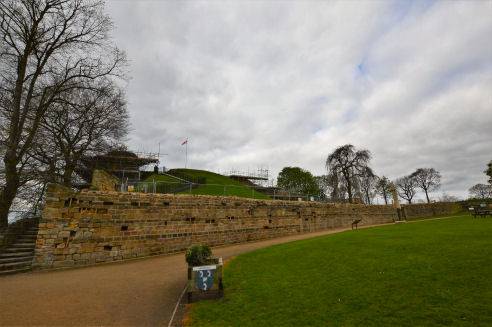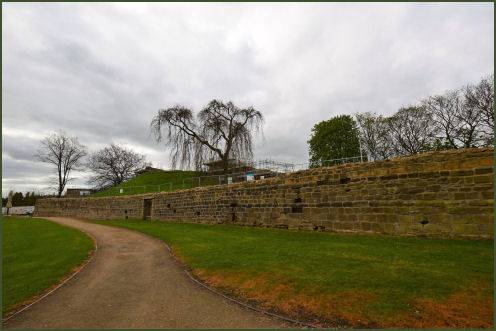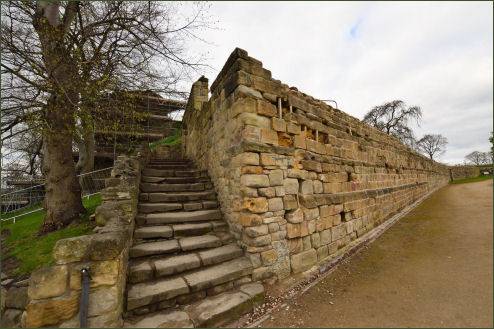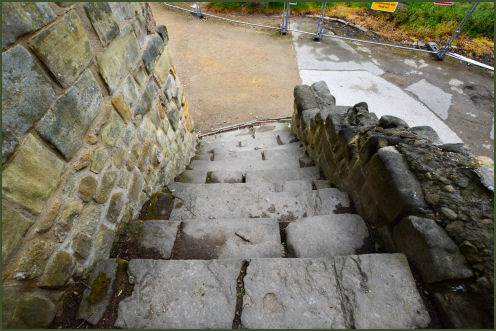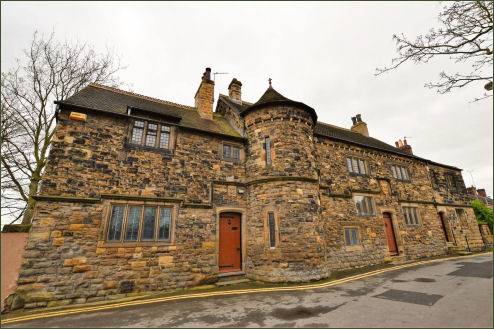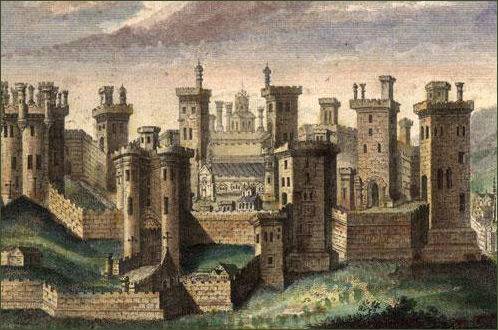Pontefract Castle
OS grid reference:-
 The ruins of Pontefract Castle stands on a rock to the east Pontefract above All Saints Church.
The ruins of Pontefract Castle stands on a rock to the east Pontefract above All Saints Church.
Little survives today of what was once one of the mightiest and most feared castle in Yorkshire. Parts of the curtain wall can be seen and some of the excavated inner walls. Parts of Piper Tower's postern gate and the foundations of a chapel are the oldest remains. The ruins of the Round Tower or keep stand atop the eleventh century mound. Chambers excavated into the rock in the inner bailey possibly indicate the site of the old hall.
The castle has a long and bloody story and has featured many times in the history of the nation. Pontefract Castle was constructed in around 1070 by Ilbert de Lacy who fought at the Battle of Hastings in 1066 and died in 1090. Ilbert was a major participant in the Harrying of the North (1069–70) in response to an Anglo-Saxon uprising against William the Conqueror.
Initially the castle was a wooden structure which was eventually replaced with stone. Ilbert's son, Robert de Lacy, 2nd Baron of Pontefract, failed to support King Henry I during his power struggle with his older brother Robert Curthose, which resulted in the castle being confiscated from the de Lacy family.
Roger de Lacy, 6th Baron of Pontefract, paid Richard the Lionheart 3,000 marks for the Honour of Pontefract, but the King still retained possession of the castle. Richard's successor, King John finally returned the castle to de Lacy in 1199.
 In 1311 the Pontefract Castle passed by marriage to the estates of the great House of Lancaster. After leading a rebellion against the rule of his cousin, King Edward II, Thomas, Earl of Lancaster (1278-1322) was beheaded outside the castle walls six days after his defeat at the Battle of Boroughbridge. King Edward II himself passed the judgement on Lancaster in the great hall. It was subsequently inherited by John of Gaunt, third son of King Edward III, through his marriage to the heiress Blanche of Lancaster. The wealthy Gaunt spent large vast amounts of money improving the castle.
In 1311 the Pontefract Castle passed by marriage to the estates of the great House of Lancaster. After leading a rebellion against the rule of his cousin, King Edward II, Thomas, Earl of Lancaster (1278-1322) was beheaded outside the castle walls six days after his defeat at the Battle of Boroughbridge. King Edward II himself passed the judgement on Lancaster in the great hall. It was subsequently inherited by John of Gaunt, third son of King Edward III, through his marriage to the heiress Blanche of Lancaster. The wealthy Gaunt spent large vast amounts of money improving the castle.
King Richard II (1367-1400) was probably murdered within Pontefract Castle after deposed by Gaunt's son, Henry IV, first king of the House of Lancaster. Although Henry was at first inclined to let his cousin Richard live, his attitude hardened when it was revealed that the earls of Huntingdon, Kent and Salisbury and Lord Despenser, and possibly also the Earl of Rutland, all now demoted from the ranks they had been given by King Richard, were planning to murder Henry and restore Richard in the Epiphany Rising. Richard met his end around the second week in February, 1400. His skeleton was examined in 1871 by Dean Stanley of Westminster but showed no marks of violence. Starvation was the most likely cause, although this has never been proven. His body was taken south from Pontefract and displayed in the old St Paul's Cathedral on 17 February before burial in Kings Langley Church on 6 March.
In 1536, Thomas Darcy, 1st Baron Darcy, the castle's guardian surrendered Pontefract Castle to the leaders of the Pilgrimage of Grace, an ill fated Catholic rebellion in northern England against the religious reforms of King Henry VIII. Lord Darcy was subsequently executed. It is alleged that in 1541, Henry's fifth wife, Catherine Howard, first committed adultery with Sir Thomas Culpeper while staying at Pontefract Castle. Mary, Queen of Scots was lodged overnight at the castle on 28 January 1569.
During the Civil War, Pontefract served as a Royalist stronghold and was besieged at least three times by Parliamentarian forces. At the end of the Civil War the castle was slighted by the Parliamentarians to prevent it being used against them again.
